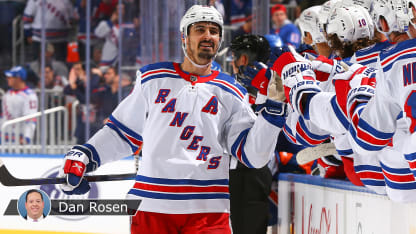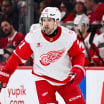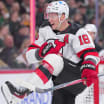Kreider said he has talked with former Boston College teammate Cam Atkinson about playing with Panarin specifically. Atkinson, now with the Philadelphia Flyers, scored an NHL career-high 41 goals as Panarin's teammate for the Columbus Blue Jackets in 2018-19.
"We talked a little bit about just getting to spots and being ready for the puck when he didn't necessarily think he was going to get the puck," Kreider said. "'Artie' is so good at hitting you with misdirection. There's been a lot of times in the last few years when I'm standing up straight and all of a sudden, it's right between my legs. If I was ready for it, I probably would have had a better opportunity. He's hard to read. Sometimes he's even hard to read for us, so it's just constantly being ready when he has the puck.
"But that also applies to Ryan Strome, to Adam Fox and to Mika. Those guys are so incredible at looking one way and putting the puck on a tee right where you are. When everyone on the ice doesn't necessarily think you're going to get the puck that's usually when those guys are giving you the puck."
Kreider, though, has been a multidimensional offensive threat this season.
He's shooting more, averaging 2.81 shots on goal per game. His NHL career average coming into the season was 2.23.
He is playing regularly on the second penalty kill unit, averaging 1:23 of shorthanded ice time per game, up from the 31 seconds he averaged last season, his NHL career high. He can create shorthanded scoring chances with his speed and anticipation.
"It's so easy to pigeon-hole him into being a strong, straight-ahead guy just going after pucks on the forecheck and being in the blue," Tortorella said. "There's a lot more to his game than that."
Said former Rangers goalie Henrik Lundqvist, "I always looked at him and said, 'He is this good but can he do it every night?' There's no question he can be a 40-goal scorer. The big thing is to be that you need to almost every night be there and so far, he's been there."
Kreider even attempted the lacrosse-style goal nicknamed "The Michigan" against the Boston Bruins on Nov. 26. Bruins goalie Jeremy Swayman got over in time to make the save.
"When you're feeling it, you're feeling it so you might as well go for it," Zibanejad said.
Kreider has been feeling it all season. It's often going for him.
"He's different," Valiquette said. "Very patient and methodical in front of the net. He's getting a lot of high-danger chances. He's more consistent than I've seen him at trusting his game. He hasn't wavered."


















